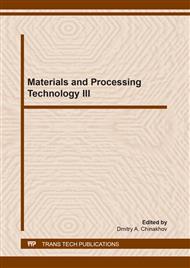[1]
V.G. Trushkov, V.P. Glazyrin, E.N. Kramshonkov Assessment of barriers material porosity on perforation capacity under the high speed shock, Russian Physics Journal, 7/2, 202 (2009).
Google Scholar
[2]
V.G. Trushkov, Numerical investigation of high-speed interaction objects of large deformation medium in the Euler space variables (2007).
Google Scholar
[3]
A.V. Zhukov, The interpolation wide-range equation of state of metals in variables: pressure, density, energy, J. Deformable solid mechanics, 70 (1987).
Google Scholar
[4]
V.F. Tolkachyov, V.G. Trushkov, Mathematical modeling of shear and spall failure processes of elastoplastic bodies under shock interaction, J. Chemical physics 2, 170 (1993).
Google Scholar
[5]
L.V. Efremova, A.I. Korneev, V. G. Trushkov, Numerical modeling of process of conic facing deformation, J. Physics of combustion and explosion 2, 110 (1987).
Google Scholar
[6]
C.V. Razorenov, G.I. Kanel, E.N. Kramshonkov, K. Baumung, Shock compression and spall failure of cobalt at normal and elevated temperatures, J. Physics of combustion and explosion 5, 119 (2002).
DOI: 10.1023/a:1020303004747
Google Scholar
[7]
E. N. Kramshonkov, A. V. Kraynov, P. V. Shorokhov, Protective Effectiveness of Porous Shields Under the Influence of High-Speed Impact Loading (Article number 01031), European Physical Journal (EPJ) Web of Conferences 110 , 1 (2016).
DOI: 10.1051/epjconf/201611001031
Google Scholar
[8]
A. V. Kraynov, G. V. Kuznetsov, Conjugate heat transfer during viscous liquid movement in the open cavity, considering its cooling through outer boundary of back surface (01023), European Physical Journal (EPJ) Web of Conferences 76, 1 (2014).
DOI: 10.1051/epjconf/20147601023
Google Scholar
[9]
A.V. Kraynov, E.N. Pashkov, A.V. Ponomarev, Conjugate Heat Transfer in the Interaction of the Viscous Liquid with Technological Elements of Energy Systems in Conditions of Their Internal Contour Moving, J.Advanced Materials Research 1040, 638 (2014).
DOI: 10.4028/www.scientific.net/amr.1040.876
Google Scholar
[10]
G.V. Kuznetsov, A.V. Krainov, Conjugate heat exchange and hydrodynamics for a viscous incompressible fluid moving in a rectangular cavity, J. Applied Mechanics and Technical Physics 5, 851 (2001).
Google Scholar
[11]
G.V. Kuznetsov, A.V. Krainov, Conjugate heat and mass transfer under conditions of motion of a viscous incompressible liquid in an open rectangular cavity and wall melting, J. High Temperature 2, 252 (2003).
Google Scholar
[12]
A.V. Kraynov, V.A. Arhipov, Conjugate Heat Transfer During Viscous Incompressible Liquid Movement in the Cavity Considering its Cooling Through Outer Boundary (Article number 01030), European Physical Journal (EPJ) Web of Conferences 110 , 1 (2016).
DOI: 10.1051/epjconf/201611001030
Google Scholar
[13]
A.V. Kraynov, E. N. Pashkov, R. E. Lushnikov, V. A. Arkhipov, Hydrodynamics and heat transfer in the coolant flows in the elements of the technical designs of industrial systems, J. Key Engineering Materials 685, 280 (2016).
DOI: 10.4028/www.scientific.net/kem.685.280
Google Scholar
[14]
Kramshonkov, E.N., Krainov, A.V., Pashkov, E.N. Porous barriers efficiency research under the compact elements high-speed loading, J. Materials Science Forum 927, 48 (2018).
DOI: 10.4028/www.scientific.net/msf.927.48
Google Scholar
[15]
Paul M. Booker, James D. Cargile, Bruce L. Kistler, Valeria La Saponara, International Journal of Impact Engineering, 36, 926 (2009).
Google Scholar
[16]
H. Wu, Q. Fang, Y. Peng, Z.M. Gong, X.Z. Kong, International Journal of Impact Engineering, 76, 232 (2015).
Google Scholar
[17]
Y.Y. Zhang, L. Chen, International Journal of Impact Engineering, 36, 651 (2009).
Google Scholar
[18]
T.T. Garfield, W.D. Richins, T.K. Larson, C.P. Pantelides, J.E. Blakeley, 11th International Conference on the Mechanical Behavior of Materials (ICM11), 10, 3534 (2011).
Google Scholar
[19]
R. T. Moura, A. H. Clausen, E. Fagerholt, M. Alves, M. Langseth, International Journal of Impact Engineering, 37, 580 (2010).
Google Scholar
[20]
Hua Jiang, Xiaowo Wang, Shuanhai He, Materials & Design, 39, 111 (2012).
Google Scholar
[21]
J.J. Rimoli, B. Talamini, J.J. Wetzel, K.P. Dharmasena, R. Radovitzky, H.N.G. Wadley, International Journal of Impact Engineering, 38, 837 (2011).
DOI: 10.1016/j.ijimpeng.2011.05.010
Google Scholar
[22]
T. Børvik, L. Olovsson, A.G. Hanssen, K.P. Dharmasena, H. Hansson, H.N.G. Wadley, Journal of the Mechanics and Physics of Solids, 5, 940 (2011).
DOI: 10.1016/j.jmps.2011.03.004
Google Scholar
[23]
C.J. Yungwirth, J. O'Connor, A. Zakraysek, V.S. Deshpande, H.N.G Wadley, Journal of the American Ceramic Society, 94, S62 (2011).
Google Scholar
[24]
Hamid Gheadnia, Ozdes Cermik, Dan B. Marghitu, International Journal of Impact Engineering, 86, 307 (2015).
Google Scholar
[25]
M. Scapin, L. Peroni, M. Peroni, International Journal of Impact Engineering, 40, 58 (2012).
Google Scholar
[26]
Yihao Cheng, Mingyang Wang, Cuncheng Shi, Hualin Fan, Lang Li, Qing, International Journal of Impact Engineering, 81, 50 (2015).
Google Scholar
[27]
G.S. Collins, H.J. Melosh, K. Wünnemann, International Journal of Impact Engineering, 38, 434 (2011).
Google Scholar
[28]
P. Forquin, A. Arias, R. Zaera, International Journal of Impact Engineering, 35, 133 (2008).
Google Scholar
[29]
G. Buyalich, M. Husnutdinov, Justification of the Shape of a Non-Circular Cross-Section for Drilling with a Roller Cutter, International Journal of Impact Engineering, E3S Web of Conferences 21, 03010 (2017).
DOI: 10.1051/e3sconf/20172103010
Google Scholar
[30]
Y.L. Zhukovskiy, N.I. Koteleva, M.S. Kovalchuk, Development of course feedback questionnaires of continuing professional education in the mining industry, Innovation-Based Development of the Mineral Resources Sector: Challenges and Prospects - 11th conference of the Russian-German Raw Materials, 589 (2019).
Google Scholar
[31]
A.V. Nikolaev, Neftyanoe Khozyaystvo - Oil Industry, 11, 133 (2016).
Google Scholar
[32]
N.I. Alymenko, A.V. Nikolaev, A.A. Kamenskikh, A.I. Petrov, Eurasian Mining, 2, 45 (2016).
Google Scholar


